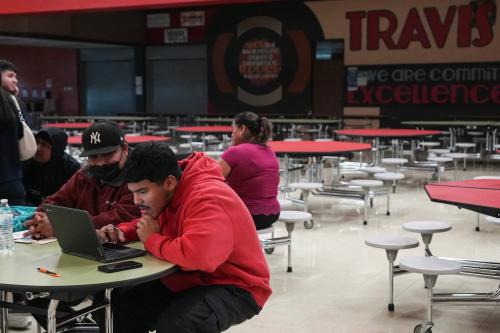If you want more content like this, subscribe to our newsletter.
This week in Class Notes:
- Online college degrees in Colombia lead to lower test scores than in-person programs.
- Social forces that hinder social mobility are partly impervious to strong welfare policies.
- Exposure to inequality causes under-investment in public goods.
- This week’s top chart shows that both low- and high-income individuals think they are closer to the middle of the income distribution than they truly are.
- Caitlin Flanagan argues that elite private schools have become engines of inequality in our society in this week’s choice op-ed.
- Check out our latest piece on why Biden’s child tax credit is not just an anti-poverty policy, but also a social mobility policy.
- For your calendar: Watch upcoming webinars on voting rights legislation, leveraging veteran talent in apprenticeship programs and regulating for-profit colleges.
Online college degrees in Colombia lead to lower test scores than in-person programs
Online school has become more prevalent than ever during the COVID-19 pandemic. Can the quality of virtual education match that of in-person learning? To answer this question, Stephanie Riegg Cellini and her co–authors study the Colombian higher education system where a significant proportion of students already complete their postsecondary degrees online. Specifically, they compare scores on a mandatory college exit exam for online and in-person students. Controlling for socioeconomic status, high school test scores, and internet access, the authors find that online students receive a significantly worse education, with lower scores in math, reading, and writing. Interestingly, the same is not true for shorter vocational and technical programs – at least for public colleges. While online students attending private vocational programs score lower on the exam than their in-person peers, those attending public technical programs actually perform better.
Social forces that hinder social mobility are partly impervious to strong welfare policies
American policymakers, especially those of a progressive inclination, often point to Denmark as a model country, where strong social policies, such as free college and universal healthcare, reduce inequality and increase social mobility. But while income inequality is significantly lower in Denmark than in the United States, the intergenerational influences on child outcomes that hinder mobility are comparable. In their new paper, James J. Heckman and Rasmus Landersø show that some of the social forces that reduce social mobility are not easily mitigated by Denmark’s strong welfare state. Key childhood development metrics, such as birthweight and language skills, differ significantly by a mother’s education level in both countries, for example. The two countries also have the same rates of intergenerational educational mobility. The authors also show that rates of intergenerational income mobility in Denmark may be overstated in studies that only look at snapshots of income, rather than lifetime earnings. Finally, social factors like the self-sorting of affluent families into affluent neighborhoods gives the well-off improved access to universal social programs.
Exposure to inequality causes under-investment in public goods
How does inequality impact economic decisionmaking? Pablo Brañas-Garza and his co–authors design a lab experiment to determine how exposure to inequality affects individuals’ decisions in a public goods game. In the game, participants are given an endowment of 20 tokens and grouped with two other players. Individuals then decide how much of their endowment to keep and how much to contribute to the public pool, which adds up all contributions and then returns them in equal parts after being multiplied by a marginal return rate of m. For instance, if m is set to .5 and every player chooses to keep 18 tokens and invest two into the public pool, players will earn (18 + .5*6) tokens. The authors introduce inequality into the game by telling participants that other group members have higher marginal return rates from the public pool (i.e. have a higher m). The paper finds that when inequality in return rates is high, contributions to the public pool significantly decrease. As the difference in return rates shrinks, so does the effect on public contributions. The findings suggest that high levels of inequality can lead to the erosion and under-provision of public goods.
Top chart: Both low- and high-income Individuals think they are closer to the middle of the income distribution than they truly are
This week’s top chart shows that individuals have biased perceptions of their relative positions on the income distribution. A new study from Denmark (yes, we’re having a rather Danish week) finds that both individuals towards the top of the income ladder and those towards the bottom perceive themselves to be closer to the middle of the distribution than they truly are. (This something I’ve previously dubbed the “Me? I’m not rich!” problem).
 Chart source: “Social Position and Fairness Views” by Kristoffer B. Hvidberg, Claus Kreiner & Stefanie Stantcheva
Chart source: “Social Position and Fairness Views” by Kristoffer B. Hvidberg, Claus Kreiner & Stefanie Stantcheva
Choice opinion: Elite private schools have become engines of inequality in our society
“[W]hat makes these schools truly ludicrous is their recent insistence that they are engines of equity and even ‘inclusivity.’ A $50,000-a-year school can’t be anything but a very expensive consumer product for the rich. If these schools really care about equity, all they need to do is get a chain and a padlock and close up shop,” writes Caitlin Flanagan.
Self-promotion: Biden’s child tax credit is not just an anti-poverty policy; it’s a social mobility policy too
In the United States, one in seven kids grows up in poverty. The Biden administration’s recent expansion of the child tax credit has generated a debate among policymakers as to how we should tackle this problem. In our latest piece, Christopher Pulliam and I show that the tax credit, which gives low- and middle-income families $3,000 per child aged 6-17 and $3,600 per child under 6, will cut child poverty rates by 45 percentage points. Conservative critics argue that this policy may improve present conditions but has adverse effects on upward social mobility in the long run. But we disagree. Previous studies show that cash-transfer programs, like the EITC and SNAP benefits, can effectively promote upward social mobility. Therefore, the child tax credit is not just a powerful anti-poverty policy; it’s a social mobility policy too.
For your calendar: voting rights legislation, leveraging veteran talent in apprenticeship programs and regulating for-profit colleges.
Voting rights and wrongs: Democracy legislation in the Senate
-
- The Brookings Institution
- Wednesday, March 24, 2021 4:00 PM – 5:30 PM EDT
Leveraging veteran talent in registered apprenticeship
-
- Urban Institute
- Tuesday, March 30, 2021 1:00 PM – 2:00 PM EDT
Stopping the cycle of abuses by for-profit colleges
-
- The Century Foundation
- Wednesday, March 31, 2021 1:00 PM – 2:00 PM EDT








Commentary
Class Notes: Exposure to inequality, elite private schools, and more
March 24, 2021